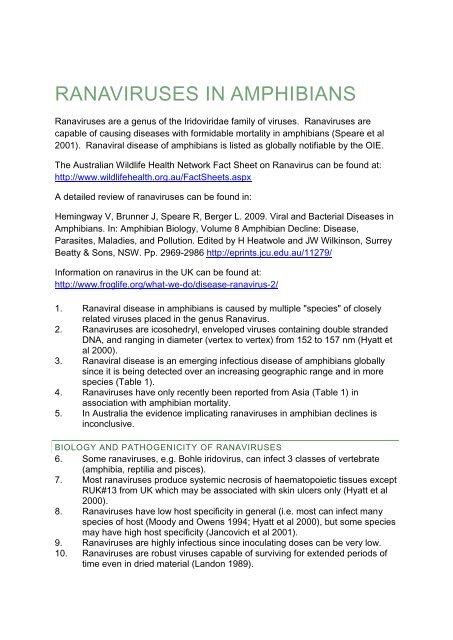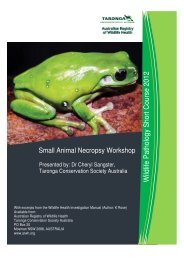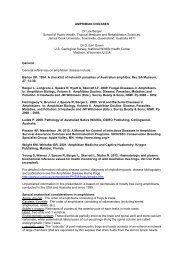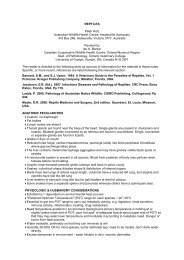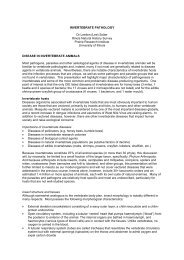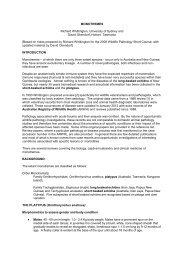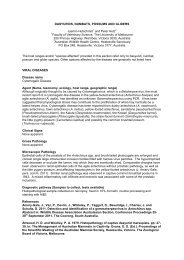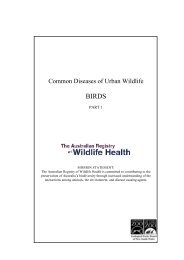ranaviruses in amphibians - Australian Registry of Wildlife Health
ranaviruses in amphibians - Australian Registry of Wildlife Health
ranaviruses in amphibians - Australian Registry of Wildlife Health
Create successful ePaper yourself
Turn your PDF publications into a flip-book with our unique Google optimized e-Paper software.
RANAVIRUSES IN AMPHIBIANSRanaviruses are a genus <strong>of</strong> the Iridoviridae family <strong>of</strong> viruses. Ranaviruses arecapable <strong>of</strong> caus<strong>in</strong>g diseases with formidable mortality <strong>in</strong> <strong>amphibians</strong> (Speare et al2001). Ranaviral disease <strong>of</strong> <strong>amphibians</strong> is listed as globally notifiable by the OIE.The <strong>Australian</strong> <strong>Wildlife</strong> <strong>Health</strong> Network Fact Sheet on Ranavirus can be found at:http://www.wildlifehealth.org.au/FactSheets.aspxA detailed review <strong>of</strong> <strong>ranaviruses</strong> can be found <strong>in</strong>:Hem<strong>in</strong>gway V, Brunner J, Speare R, Berger L. 2009. Viral and Bacterial Diseases <strong>in</strong>Amphibians. In: Amphibian Biology, Volume 8 Amphibian Decl<strong>in</strong>e: Disease,Parasites, Maladies, and Pollution. Edited by H Heatwole and JW Wilk<strong>in</strong>son, SurreyBeatty & Sons, NSW. Pp. 2969-2986 http://epr<strong>in</strong>ts.jcu.edu.au/11279/Information on ranavirus <strong>in</strong> the UK can be found at:http://www.froglife.org/what-we-do/disease-ranavirus-2/1. Ranaviral disease <strong>in</strong> <strong>amphibians</strong> is caused by multiple "species" <strong>of</strong> closelyrelated viruses placed <strong>in</strong> the genus Ranavirus.2. Ranaviruses are icosohedryl, enveloped viruses conta<strong>in</strong><strong>in</strong>g double strandedDNA, and rang<strong>in</strong>g <strong>in</strong> diameter (vertex to vertex) from 152 to 157 nm (Hyatt etal 2000).3. Ranaviral disease is an emerg<strong>in</strong>g <strong>in</strong>fectious disease <strong>of</strong> <strong>amphibians</strong> globallys<strong>in</strong>ce it is be<strong>in</strong>g detected over an <strong>in</strong>creas<strong>in</strong>g geographic range and <strong>in</strong> morespecies (Table 1).4. Ranaviruses have only recently been reported from Asia (Table 1) <strong>in</strong>association with amphibian mortality.5. In Australia the evidence implicat<strong>in</strong>g <strong>ranaviruses</strong> <strong>in</strong> amphibian decl<strong>in</strong>es is<strong>in</strong>conclusive.BIOLOGY AND PATHOGENICITY OF RANAVIRUSES6. Some <strong>ranaviruses</strong>, e.g. Bohle iridovirus, can <strong>in</strong>fect 3 classes <strong>of</strong> vertebrate(amphibia, reptilia and pisces).7. Most <strong>ranaviruses</strong> produce systemic necrosis <strong>of</strong> haematopoietic tissues exceptRUK#13 from UK which may be associated with sk<strong>in</strong> ulcers only (Hyatt et al2000).8. Ranaviruses have low host specificity <strong>in</strong> general (i.e. most can <strong>in</strong>fect manyspecies <strong>of</strong> host (Moody and Owens 1994; Hyatt et al 2000), but some speciesmay have high host specificity (Jancovich et al 2001).9. Ranaviruses are highly <strong>in</strong>fectious s<strong>in</strong>ce <strong>in</strong>oculat<strong>in</strong>g doses can be very low.10. Ranaviruses are robust viruses capable <strong>of</strong> surviv<strong>in</strong>g for extended periods <strong>of</strong>time even <strong>in</strong> dried material (Landon 1989).
11. Acl<strong>in</strong>ical carrier states with <strong>ranaviruses</strong> occur, and are probably the mostcommon state <strong>in</strong> wild <strong>amphibians</strong>.12. Movement <strong>of</strong> <strong>ranaviruses</strong> <strong>in</strong>to an area will most probably be by movement <strong>of</strong><strong>in</strong>fected <strong>amphibians</strong>, fish or reptiles and <strong>in</strong>fected equipment and other<strong>in</strong>animate objects that have been contam<strong>in</strong>ated by <strong>ranaviruses</strong>.13. Once detected <strong>in</strong> an area, <strong>ranaviruses</strong> are not consistently detectedthereafter.14. Ranaviruses may be able to survive <strong>in</strong> the environment without a host, but willnot multiply.15. Ranaviruses are capable <strong>of</strong> caus<strong>in</strong>g a high <strong>in</strong>cidence <strong>of</strong> morbidity andmortality <strong>in</strong> <strong>amphibians</strong> <strong>in</strong> captivity and experimentally.16. Ranaviruses can cause a high <strong>in</strong>cidence <strong>of</strong> morbidity and mortality <strong>in</strong> somespecies <strong>of</strong> <strong>amphibians</strong> <strong>in</strong> the wild.17. In Australia there have been no epidemics <strong>of</strong> ranaviral disease detected <strong>in</strong>wild <strong>amphibians</strong>.18. The pathological outcome <strong>of</strong> <strong>in</strong>fection <strong>of</strong> <strong>amphibians</strong> with <strong>ranaviruses</strong> isvariable and difficult to predict.19. Some factors which determ<strong>in</strong>e this outcome are known (age <strong>of</strong> host, viralcharacteristics), but the environmental factors that determ<strong>in</strong>e the outcome areunknown (e.g. pollution, UV, climate).20. Chronic ranaviral disease <strong>in</strong> <strong>amphibians</strong> can occur experimentally and <strong>in</strong> thewild.21. The significance <strong>of</strong> chronic ranaviral disease on wild amphibian populations isunknown.22. The potential for amphibian carriers <strong>of</strong> <strong>ranaviruses</strong> to release viral particles<strong>in</strong>to the environment is unknown.Table 1: Ranaviruses reported from <strong>amphibians</strong>.Location Virus Species ReferenceAsiaCh<strong>in</strong>a Tiger frog virus (TFV) Tiger frog Rana tigr<strong>in</strong>a He et al 2002Rana grylio virus (RGV) Rana grylio Zhang QiYa et al 2001Thailand RTV Tiger frog Rana tigr<strong>in</strong>a Ahne & Essbauer 2001OceaniaAustralia Bohle Iridovirus (BIV) Ornate burrow<strong>in</strong>g frogLimnodynastes ornatusSpeare & Smith 1992EuropeUK RUK Common frog Rana temporaria Drury et al 1995;Hyatt et al 2000
Rana esculenta iridovirus(REIR)Edible frog Rana esculenta Ahne et al 1998North AmericaBUK Common toad Bufo bufo Essbauer & Ahne 2001Canada Reg<strong>in</strong>a ranavirus (RRV) Tiger salamander Ambystomatigr<strong>in</strong>um diabolicBoll<strong>in</strong>ger et al 1999USA Tadpole edema virus (TEV) North American bullfrog RanacatesbianaWolf et al 1968Frog virus 3 (FV3), (FV1, 2,9-23), LT1-LT4Leopard frog Rana pipiens Hyatt et al 2000Ambystoma tigr<strong>in</strong>um virus(ATV)Tiger salamander Ambystomatigr<strong>in</strong>um stebb<strong>in</strong>siJancovich et al 2001T6-20 Red eft Diemictylus viridescens Essbauer & Ahne 2001NVT Notophthalmus viridescens Essbauer & Ahne 2001TEV, Redwoodvirus Red legged frog Rana aurora Essbauer & Ahne 2001FV1-3, FV9-23 Leopard frog Rana pipiens Essbauer & Ahne 2001XVSouth AmericaAfrican clawed toad XenopuslaevisEssbauer & Ahne 2001Venezuela Guatopo virus Cane toad Bufo mar<strong>in</strong>us Hyatt et al 2000LSV Tiger frog Rana tigr<strong>in</strong>a Essbauer & Ahne 2001EPIDEMIOLOGY23. The epidemiology <strong>of</strong> <strong>ranaviruses</strong> is best understood <strong>in</strong> North America and UKwhere local and general epidemics with high mortality have been reported(Wolf et al 1968; Drury et al 1995; Jancovich et al 2001).24. In Australia the epidemiology <strong>of</strong> <strong>ranaviruses</strong> <strong>in</strong> wild <strong>amphibians</strong> is notunderstood s<strong>in</strong>ce although <strong>ranaviruses</strong> occur there have been no outbreaks
or disease detected <strong>in</strong> wild <strong>amphibians</strong> although field <strong>in</strong>vestigations havebeen limited.25. Serological studies on Bufo mar<strong>in</strong>us show that <strong>ranaviruses</strong> are present <strong>in</strong>New South Wales, Queensland and Northern Territory (Zupanovic et al 1998).Fresh water tortoises <strong>in</strong> North Queensland also have antibodies aga<strong>in</strong>st<strong>ranaviruses</strong> (Ariel 1997).26. Serological studies have not been done on other <strong>amphibians</strong> <strong>in</strong> Australias<strong>in</strong>ce suitable techniques have not been developed for any species other thanB. mar<strong>in</strong>us.27. Of the two endemic <strong>ranaviruses</strong> <strong>in</strong> Australia, Bohle Iridovirus (BIV) andEpizootic Haematopoeitic Necrosis Virus (EHNV), only BIV appears capable<strong>of</strong> <strong>in</strong>fect<strong>in</strong>g <strong>amphibians</strong>.28. BIV can also experimentally <strong>in</strong>fect a number <strong>of</strong> native and <strong>in</strong>troducedfreshwater fish, freshwater turtles, and snakes (Moody and Owens 1994; Ariel1997).29. Some other <strong>ranaviruses</strong> found outside Australia can cause experimentaldisease <strong>in</strong> native <strong>Australian</strong> <strong>amphibians</strong> (Zupanovich et al 1998). Guatapovirus killed the green tree frog Litoria caerulea.30. The potential <strong>of</strong> foreign <strong>ranaviruses</strong> and those <strong>in</strong>tercepted <strong>in</strong> imported fish andreptiles to cause disease <strong>in</strong> <strong>Australian</strong> <strong>amphibians</strong> is unknown.31. From experimental trials and the epidemiology <strong>of</strong> <strong>ranaviruses</strong> overseas, themost likely outcome <strong>of</strong> a new ranavirus <strong>in</strong> Australia would be epidemicdisease <strong>of</strong> an unpredictable extent.32. This scenario means that <strong>ranaviruses</strong> may be highly significant to <strong>amphibians</strong>that have small populations conf<strong>in</strong>ed to small geographic areas.DIAGNOSIS / DETECTION33. Cl<strong>in</strong>ical signs <strong>of</strong> acute ranaviral disease are seen <strong>in</strong> tadpoles, metamorphs,juveniles and adults: Tadpoles - decreased activity, ascites, focalhaemorrhages, death. Metamorphs - decreased activity, anasarca, ascites,focal haemorrhages, death. Adults - decreased activity, sk<strong>in</strong> ulceration, focalhaemorrhages, death.34. For laboratory diagnosis <strong>of</strong> ranaviral disease <strong>in</strong> dead animals submit fresh orfrozen carcases, fresh or frozen tissues (spleen or kidney is best), or tissuesfixed <strong>in</strong> 10% formal<strong>in</strong> or 70% ethyl alcohol.35. The current rout<strong>in</strong>e techniques for diagnos<strong>in</strong>g <strong>ranaviruses</strong> <strong>in</strong> <strong>amphibians</strong> arehistology, virus isolation from tissues, capture ELISA, and PCR. Low grade<strong>in</strong>fections (carrier state) may only be detectable by PCR.36. The significance <strong>of</strong> serological tests for ranaviral antibodies <strong>in</strong> terms <strong>of</strong><strong>in</strong>dicat<strong>in</strong>g potential for viral shedd<strong>in</strong>g is unknown.37. Laboratory diagnosis <strong>of</strong> ranaviral disease <strong>in</strong> live animals is less sensitive38. Marsh et al 2002 described a simple test us<strong>in</strong>g the major capsid prote<strong>in</strong> geneto identify species <strong>of</strong> ranavirus once isolated <strong>in</strong> culture.DISINFECTION39. Glutaraldehyde, bleach and artificially generated ultraviolet light are effectivedis<strong>in</strong>fectants.40. Ethyl alcohol is not an effective dis<strong>in</strong>fectant for <strong>ranaviruses</strong>.
SAFETY41. Individuals work<strong>in</strong>g with live <strong>ranaviruses</strong> must realise that they are deal<strong>in</strong>gwith pathogens that are highly virulent to <strong>amphibians</strong> and must adopt suitablestandards <strong>of</strong> bioconta<strong>in</strong>ment to prevent release <strong>of</strong> laboratory cultures to thewild.42. The standard <strong>of</strong> bioconta<strong>in</strong>ment needed for <strong>ranaviruses</strong> is higher than thatrequired for B. dendrobatidis.43. The risks <strong>in</strong> transmitt<strong>in</strong>g <strong>ranaviruses</strong> by various activities due to humans<strong>in</strong>teract<strong>in</strong>g with <strong>amphibians</strong> (handl<strong>in</strong>g, etc) need to be quantified to enablebest practices to be chosen.44. Ranaviruses will not <strong>in</strong>fect humans s<strong>in</strong>ce they will not multiply above 33°C.45. Strategies need to be developed to decrease the risk <strong>of</strong> commercial culture <strong>of</strong><strong>amphibians</strong> on a mass scale pollut<strong>in</strong>g the natural environment with<strong>ranaviruses</strong>.REFERENCESAhne W, Bearzotti M, Bremont M, Essbauer S. 1998. Comparison <strong>of</strong> Europeansystemic pisc<strong>in</strong>e and amphibian iridoviruses with epizootic haematopoietic necrosisvirus and frog virus 3. Zentralbl Veter<strong>in</strong>armed [B] 45(6):373-383.Ariel E. 1997. Pathology and serological aspects <strong>of</strong> Bohle iridoviral <strong>in</strong>fections <strong>in</strong> 6selected water-associated reptiles <strong>in</strong> North Queensland. PhD thesis: James CookUniversity, Townsville.Boll<strong>in</strong>ger TK, Mao J, Schock D, Brigham RM, Ch<strong>in</strong>char VG. 1999. Pathology,isolation, and prelim<strong>in</strong>ary molecular characterization <strong>of</strong> a novel iridovirus from tigersalamanders <strong>in</strong> Saskatchewan. Journal <strong>of</strong> <strong>Wildlife</strong> Diseases 35(3):413-429.Drury SEN, Gough RE, Cunn<strong>in</strong>gham AA. 1995. Isolation <strong>of</strong> an iridovirus like - agentfrom common frogs (Rana temporaria). Veter<strong>in</strong>ary Record 137:72-73.Essbauer, S., Ahne, W., 2001. Viruses <strong>of</strong> lower vertebrates. J. Vet. Med., B 48, 403–475.He JG, Lu L, Deng M, He HH, Weng SP, Wang XH, Zhou SY, Long QX, Wang XZ,Chan SM. 2002. Sequence analysis <strong>of</strong> the complete genome <strong>of</strong> an iridovirus isolatedfrom the tiger frog. Virology 292(2):185-197.Hyatt AD, Gould AR, Zupanovic Z, Cunn<strong>in</strong>gham AA, Hengstberger S, Whitt<strong>in</strong>gtonRJ, Kattenbelt J, Coupar BEH. 2000. Comparative studies <strong>of</strong> pisc<strong>in</strong>e and amphibianiridoviruses. Archives <strong>of</strong> Virology 145(2):301-331.Jancovich JK, Davids EW, Seiler A, Jacobs BL, Coll<strong>in</strong>s JP. 2001. Transmission <strong>of</strong>the Ambystoma tigr<strong>in</strong>um virus to alternative hosts. Diseases <strong>of</strong> Aquatic Organisms46(3):159-163.
Langdon JS. 1989. Experimental transmission and pathogenicity <strong>of</strong> epizootichaematopoietic necrosis virus (EHNV) <strong>in</strong> redf<strong>in</strong> perch, Perca fluviatilis L., and 11other teleosts. Journal <strong>of</strong> Fish Diseases 12:295-310.Moody NJG, Owens L. 1994. Experimental demonstration <strong>of</strong> the pathogenicity <strong>of</strong> afrog virus, Bohle iridovirus, for a fish species, barramundi – Lates calcarifer.Diseases <strong>of</strong> Aquatic Organisms 18(2):95-102.Speare R, Smith JR. 1992. An iridovirus isolated from the ornate burrow<strong>in</strong>g frog(Limnodynastes ornatus) <strong>in</strong> northern Australia. Diseases <strong>of</strong> Aquatic Organisms14:51-57.Speare R. 2001. Steer<strong>in</strong>g Committee for Gett<strong>in</strong>g the Jump on Amphibian Disease.Develop<strong>in</strong>g management strategies to control amphibian diseases: decreas<strong>in</strong>g therisks due to communicable disease. School <strong>of</strong> Public <strong>Health</strong> and Tropical Medic<strong>in</strong>e,James Cook University. Pp 1-209.Wolf K, Bullock GL, Dunbar CE, Quimby MC. 1968. Tadpole edema virus: aviscerotropic pathogen for anuran <strong>amphibians</strong>. Journal <strong>of</strong> Infectious Diseases118:253-262.Zhang QiYa, Xiao Feng, Li ZhenQiu, Gui JianFang, Mao J<strong>in</strong>ghe, Ch<strong>in</strong>char, V. G.2001. Characterization <strong>of</strong> an iridovirus from the cultured pig frog Rana grylio withlethal syndrome. Diseases <strong>of</strong> Aquatic Organisms 48(1): 27-36.Zupanovic Z, Lopez G, Hyatt AD, Green B, Bartran G, Parkes H, Whitt<strong>in</strong>gton RJ,Speare R. 1998. Giant toads Bufo mar<strong>in</strong>us <strong>in</strong> Australia and Venezuela haveantibodies aga<strong>in</strong>st "<strong>ranaviruses</strong>". Diseases <strong>of</strong> Aquatic Organisms 32:1-8.


